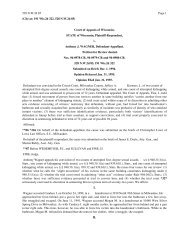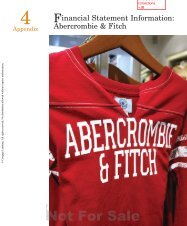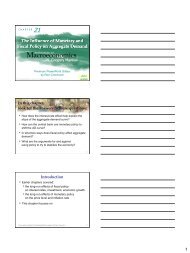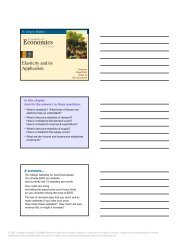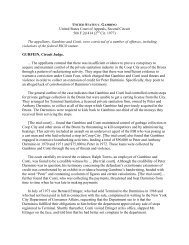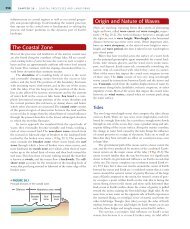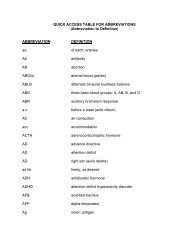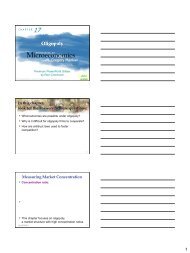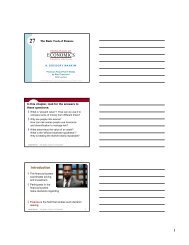Economics - Cengage Learning
Economics - Cengage Learning
Economics - Cengage Learning
Create successful ePaper yourself
Turn your PDF publications into a flip-book with our unique Google optimized e-Paper software.
N. Gregory Mankiw<br />
Principles of<br />
<strong>Economics</strong><br />
Sixth Edition<br />
9<br />
Application:<br />
International Trade Premium<br />
PowerPoint<br />
Slides by<br />
Ron Cronovich<br />
In this chapter,<br />
look for the answers to these questions:<br />
• What determines how much of a good a country<br />
will import or export?<br />
• Who benefits from trade? Who does trade<br />
harm? Do the gains outweigh the losses?<br />
• If policymakers restrict imports, who benefits?<br />
Who is harmed? Do the gains from restricting<br />
imports outweigh the losses?<br />
• What are some common arguments for<br />
restricting trade? Do they have merit?<br />
Introduction<br />
§ Recall from Chapter 3:<br />
A country has a comparative advantage in a<br />
good<br />
Countries can gain from trade if each exports the<br />
goods in which it has a comparative advantage.<br />
§ Now we apply the tools of welfare economics<br />
to see where these gains come from and<br />
who gets them.<br />
© 2012 <strong>Cengage</strong><strong>Learning</strong>. All Rights Reserved. May not be copied, scanned, or duplicated, in whole or in part, except for use as permitted in alicense<br />
distributed with a certain product or service or otherwise on a password-protected website for classroom use.<br />
1<br />
2
The World Price and<br />
Comparative Advantage<br />
§ P W =<br />
§ P D =<br />
§ If P D < P W,<br />
§ If P D > P W,<br />
The Small Economy Assumption<br />
§ A small economy<br />
§ Not always true—especially for the U.S.—but<br />
simplifies the analysis without changing its lessons.<br />
§ When a small economy engages in free trade,<br />
P W is the only relevant price:<br />
A Country That Exports Soybeans<br />
Without trade,<br />
P D = $4<br />
Q = 500<br />
P W = $6<br />
Under free trade,<br />
§ domestic<br />
consumers<br />
demand _____<br />
§ domestic producers<br />
supply _____<br />
§<br />
$4<br />
P<br />
Soybeans<br />
500<br />
D<br />
S<br />
Q<br />
© 2012 <strong>Cengage</strong><strong>Learning</strong>. All Rights Reserved. May not be copied, scanned, or duplicated, in whole or in part, except for use as permitted in alicense<br />
distributed with a certain product or service or otherwise on a password-protected website for classroom use.<br />
3<br />
4<br />
5
A Country That Exports Soybeans<br />
Without trade,<br />
CS =<br />
PS =<br />
Total surplus =<br />
With trade,<br />
CS =<br />
PS =<br />
Total surplus =<br />
ACTIVE LEARNING 1<br />
Analysis of trade<br />
Without trade,<br />
P D = $3000, Q = 400<br />
In world markets,<br />
P W = $1500<br />
Under free trade,<br />
how many TVs<br />
will the country<br />
import or export?<br />
Identify CS, PS, and<br />
total surplus without<br />
trade, and with trade.<br />
$6<br />
$4<br />
$3000<br />
$1500<br />
P<br />
P<br />
A<br />
C<br />
B<br />
200<br />
Soybeans<br />
D<br />
Plasma TVs<br />
D<br />
S<br />
400 600<br />
Summary: The Welfare Effects of Trade<br />
direction of trade<br />
consumer surplus<br />
producer surplus<br />
total surplus<br />
P D < P W<br />
P D > P W<br />
Whether a good is imported or exported,<br />
trade creates winners and losers.<br />
But<br />
Q<br />
S<br />
D<br />
© 2012 <strong>Cengage</strong><strong>Learning</strong>. All Rights Reserved. May not be copied, scanned, or duplicated, in whole or in part, except for use as permitted in alicense<br />
distributed with a certain product or service or otherwise on a password-protected website for classroom use.<br />
6<br />
Q<br />
10
Other Benefits of International Trade<br />
§ Consumers<br />
§ Producers<br />
§ Competition from abroad<br />
§ Trade<br />
Then Why All the Opposition to Trade?<br />
§ Recall one of the Ten Principles from Chapter 1:<br />
Trade can make everyone better off.<br />
§<br />
§ Yet, such compensation rarely occurs.<br />
§<br />
§ Hence, the losers have more incentive to organize<br />
and lobby for restrictions on trade.<br />
Tariff: An Example of a Trade Restriction<br />
§ Example: Cotton shirts<br />
P W = $20<br />
Tariff: T = $10/shirt<br />
Consumers must pay $____ for an imported shirt.<br />
So, domestic producers can charge $____ per shirt.<br />
§ In general, the price facing domestic buyers &<br />
sellers equals<br />
11<br />
12<br />
13<br />
© 2012 <strong>Cengage</strong><strong>Learning</strong>. All Rights Reserved. May not be copied, scanned, or duplicated, in whole or in part, except for use as permitted in alicense<br />
distributed with a certain product or service or otherwise on a password-protected website for classroom use.
Analysis of a Tariff on Cotton Shirts<br />
P W = $20<br />
Free trade:<br />
buyers demand ____<br />
sellers supply ____<br />
imports = ____<br />
T = $10/shirt<br />
price rises to ____<br />
buyers demand ____<br />
sellers supply ____<br />
imports = ____<br />
$20<br />
P<br />
25<br />
Cotton shirts<br />
Analysis of a Tariff on Cotton Shirts<br />
Free trade<br />
CS =<br />
PS =<br />
Total surplus =<br />
Tariff<br />
CS =<br />
PS =<br />
Revenue =<br />
Total surplus =<br />
$30<br />
$20<br />
P<br />
25<br />
Cotton deadweight shirts<br />
loss =<br />
40<br />
Import Quotas:<br />
Another Way to Restrict Trade<br />
§<br />
G<br />
C<br />
A<br />
D<br />
B<br />
E<br />
F<br />
80<br />
70 80<br />
§ Mostly has the same effects as a tariff:<br />
§ Raises price, reduces quantity of imports.<br />
§ Reduces buyers’ welfare.<br />
§ Increases sellers’ welfare.<br />
§ A tariff creates revenue for the govt. A quota<br />
§ Or, govt could auction licenses to import to capture<br />
this profit as revenue. Usually it does not.<br />
S<br />
S<br />
D<br />
Q<br />
14<br />
D<br />
Q<br />
15<br />
17<br />
© 2012 <strong>Cengage</strong><strong>Learning</strong>. All Rights Reserved. May not be copied, scanned, or duplicated, in whole or in part, except for use as permitted in alicense<br />
distributed with a certain product or service or otherwise on a password-protected website for classroom use.
16%<br />
14%<br />
12%<br />
10%<br />
Arguments for Restricting Trade<br />
1. The jobs argument<br />
Economists’ response:<br />
8%<br />
6%<br />
4%<br />
2%<br />
0%<br />
Look at the data to see whether rising imports<br />
cause rising unemployment…<br />
U.S. Imports & Unemployment,<br />
Decade averages, 1961–2010<br />
1961-<br />
1970<br />
1971-<br />
1980<br />
1981-<br />
1990<br />
1991-<br />
2000<br />
Imports<br />
2001-<br />
2010<br />
(% of GDP)<br />
Arguments for Restricting Trade<br />
1. The jobs argument<br />
18<br />
Unemployment<br />
(% of labor force)<br />
Trade destroys jobs in the industries that compete<br />
against imports.<br />
Economists’ response:<br />
Total unemployment does not rise as imports rise,<br />
because<br />
Even if all goods could be produced more<br />
cheaply abroad, the country need only have a<br />
_______________________ to have a viable<br />
export industry and to gain from trade.<br />
20<br />
© 2012 <strong>Cengage</strong><strong>Learning</strong>. All Rights Reserved. May not be copied, scanned, or duplicated, in whole or in part, except for use as permitted in alicense<br />
distributed with a certain product or service or otherwise on a password-protected website for classroom use.
Arguments for Restricting Trade<br />
2. The national security argument<br />
Economists’ response:<br />
Arguments for Restricting Trade<br />
3. The infant-industry argument<br />
Economists’ response:<br />
Besides, if a firm will be profitable in the long run,<br />
it should be willing to incur temporary losses.<br />
Arguments for Restricting Trade<br />
4. The unfair-competition argument<br />
Economists’ response:<br />
Great! Then we can import extra-cheap products<br />
subsidized by the other country’s taxpayers.<br />
21<br />
22<br />
23<br />
© 2012 <strong>Cengage</strong><strong>Learning</strong>. All Rights Reserved. May not be copied, scanned, or duplicated, in whole or in part, except for use as permitted in alicense<br />
distributed with a certain product or service or otherwise on a password-protected website for classroom use.
Arguments for Restricting Trade<br />
5. The protection-as-bargaining-chip argument<br />
Example:<br />
Economists’ response:<br />
Suppose France refuses. Then the U.S. must<br />
choose between two bad options:<br />
A) Restrict imports from France,<br />
B) Don’t restrict imports,<br />
Trade Agreements<br />
§ A country can liberalize trade with<br />
§ unilateral reductions in trade restrictions<br />
§ multilateral agreements with other nations<br />
§ Examples of trade agreements:<br />
§ World Trade Organization (WTO), est. 1995,<br />
24<br />
25<br />
© 2012 <strong>Cengage</strong><strong>Learning</strong>. All Rights Reserved. May not be copied, scanned, or duplicated, in whole or in part, except for use as permitted in alicense<br />
distributed with a certain product or service or otherwise on a password-protected website for classroom use.



